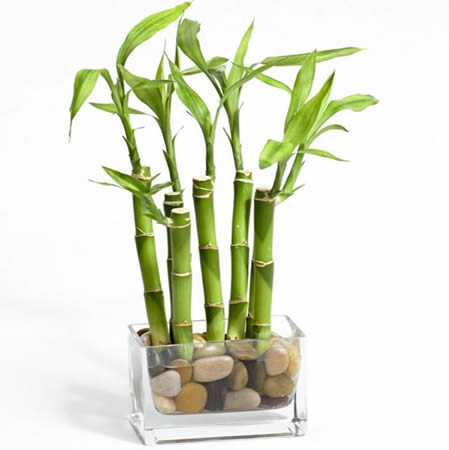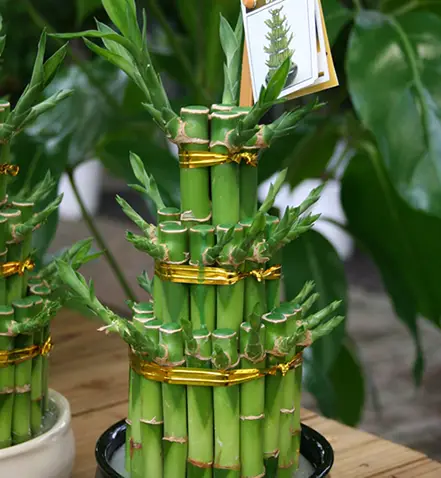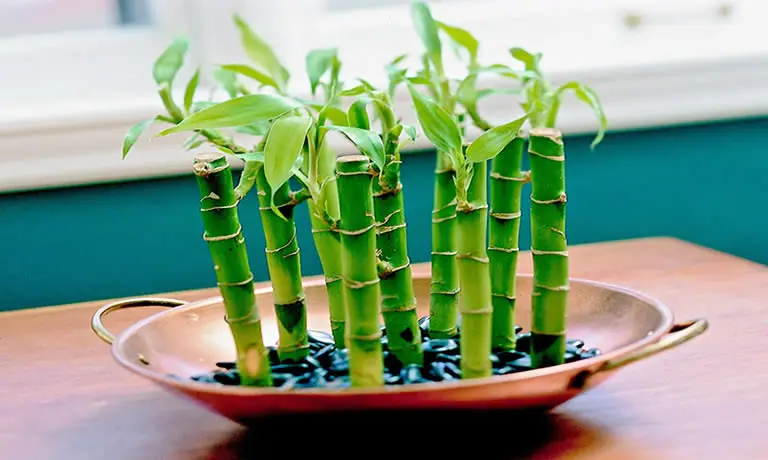Lucky Bamboo (Dracaena sanderiana) is a plant with a calm, sculptural presence that brings elegance and symbolism into your home. Often associated with good fortune and feng shui, it’s not actually a true bamboo—but it’s easy to care for, adaptable, and looks great in everything from minimalist containers to decorative arrangements. Whether you grow it in water or soil, Lucky Bamboo makes a peaceful, low-maintenance companion.
Here’s how to keep your Lucky Bamboo healthy, vibrant, and full of positive energy.
Table of Contents
- Light Needs: Bright but Gentle
- Growing in Water: Simple, Stylish, and Effective
- Growing in Soil: A More Traditional Option
- Temperature and Humidity: Keep It Warm and Calm
- Fertilizing: Less Is More
- Pruning and Shaping: Keeping It Tidy
- Best Spot in the Home: Where Lucky Bamboo Thrives
- Common Problems and Fixes
- Final Thoughts
Light Needs: Bright but Gentle
Lucky Bamboo prefers bright, indirect light.
A spot near a north or east-facing window is ideal.

Avoid direct sunlight, which can scorch the leaves and bleach the stalks.
If the leaves start to fade or turn yellow, it may be getting too much light.
In lower light, growth slows but the plant usually holds its shape well.
Growing in Water: Simple, Stylish, and Effective
Lucky Bamboo is often grown in water, which is both decorative and easy to maintain.
Use a clear or opaque container, like these, with at least one to three inches of water—enough to cover the roots but not the stalks.
Support the plant with smooth stones or glass pebbles, and keep the roots anchored in place.
Change the water every one to two weeks, using filtered or distilled water.
Tap water with high chlorine or fluoride levels can damage the plant over time.
If leaves begin turning brown at the tips, poor water quality is often the cause.
Clean the container and rinse the roots each time you change the water.

You can also add a drop of liquid houseplant fertilizer once a month, but be very sparing.
The best fertilizer to use in water is a balanced liquid fertilizer designed for hydroponic or water-grown plants, diluted to one-tenth strength.
Too much fertilizer will burn the roots and lead to yellowing leaves.
Growing in Soil: A More Traditional Option
While less common, Lucky Bamboo can be grown in soil. Use a loose, well-draining potting mix and keep the soil lightly moist—not soggy.
Water with distilled or filtered water and let the top inch of soil dry slightly between waterings.
Make sure the container has drainage holes or that you water carefully to avoid root rot.
Temperature and Humidity: Keep It Warm and Calm
Lucky Bamboo prefers temperatures between 65°F and 90°F and doesn’t tolerate cold drafts or sudden drops in temperature.
It’s not fussy about humidity but does appreciate stable conditions.
Avoid placing it near air vents or heaters.
Fertilizing: Less Is More
Lucky Bamboo needs very little fertilizer, especially if grown in water.
If it’s in soil, feed every 6 to 8 weeks during spring and summer with a balanced, low-salt liquid fertilizer made for Dracaena or general-purpose houseplants, diluted to half strength.
A good 10-10-10 fertilizer, like this, works well with this plant.

For water-grown plants, use a specialized liquid hydroponic fertilizer, like this FloraBloom at one-tenth the recommended strength and only once a month.
Over-fertilizing is a common mistake and often leads to yellowing or root damage.
Pruning and Shaping: Keeping It Tidy
Trim off any yellowing leaves or dying roots to keep the plant healthy.
If stalks grow too tall, you can cut just above a node and encourage new shoots to grow from that point.
Use clean, sharp scissors or pruning shears, and consider replanting trimmed stalks to create fuller arrangements.
Best Spot in the Home: Where Lucky Bamboo Thrives
Lucky Bamboo is perfect for offices, kitchen counters, bathrooms, or living room shelves where it gets bright, filtered light and a calm environment.
Many people place it in entryways or workspaces as a feng shui enhancer.
Its upright growth and symbolism make it feel grounding and intentional in any space.
Common Problems and Fixes
Yellow leaves are usually caused by poor water quality or over-fertilizing
Fix it by switching to distilled water and reducing feeding frequency
Brown leaf tips often mean the air is too dry or there’s too much chlorine in the water
Fix it by misting occasionally and using filtered water

Slimy roots or mushy stalks are signs of stagnant water or rot
Fix it by rinsing the roots, trimming away any mushy parts, and placing the stalks in fresh, clean water
Slow or no growth is normal in low light but could also mean nutrient deficiency
Fix it by improving the lighting and adding a very mild dose of hydroponic fertilizer once a month
Final Thoughts
Lucky Bamboo is more than just an easy-care plant—it’s a living symbol of harmony, resilience, and balance.
Whether growing in a vase of water or a pot of soil, it brings beauty with almost no fuss.
With gentle light, clean water, and a light touch on fertilizer, it will quietly thrive and bring good vibes into your space year-round.

